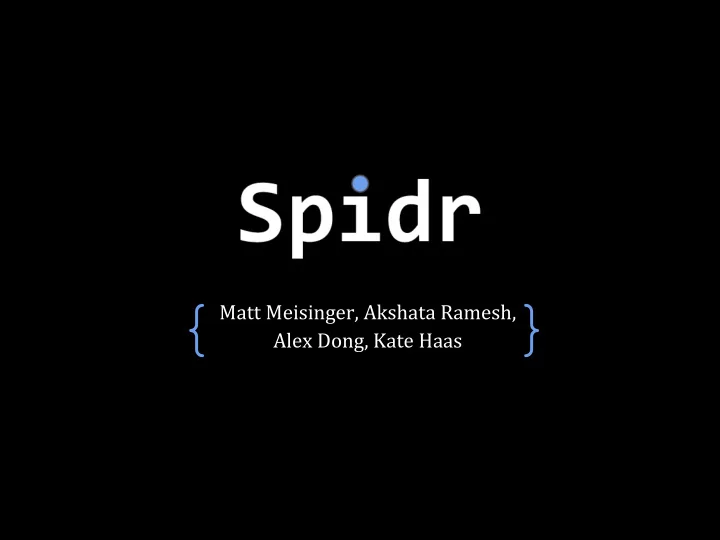

{ } Matt Meisinger, Akshata Ramesh, Alex Dong, Kate Haas
Motivation ● Easy HTML manipulation: for extracting images, links, and other content from specific portions of the page. ● Traversing the hierarchical structure of an HTML page in a not-too- complicated manner. ● For example, might want to retrieve all links that a given url is linked to. ● If using Java, need to add extra Java-specific code, libraries, etc. ● Make something that has familiar Java/C++ type syntax, yet does not contain a lot of pre-processing.
Initial Idea ● Have an object oriented structure for the language: have Url, Page, and others as objects. ● Implement helper functions to make frequent processes easier to re- compute. ● Keep syntax close to Java/C++ which we are all familiar with. ● Sounded too much like Java! So, decided to discard the object-oriented construct and some of the syntax. ● Decouple HTML parsing. Could be handled by something else: like a library in another language. ● Started working with Java's JSoup HTML parsing library. ● Chose JSoup because it seemed intuitive, and uses jQuery-like selectors to pick out parts of the HTML. ● Finally came up with something simpler than our initial idea, yet rigorous.
Tutorial I function int foo(int x){ function void main(){ int a = x string s = "Hello World" double b = 2.5 println(s) boolean = true /*or false*/ } if(a) {return 2} else {return 3} } ● 3 different loop structures: typical for/while, and a special 'loop' which is very much like a for-each: int[] list = [1,2,3] loop(list i) print(i) /*prints 123*/ ● List initializers, unlike Java, may be passed as arguments of functions: print([1,2,3])
Tutorial II : The Return ● Special types: urls and selectors. ● url Created from a string using the colon operator: -> string columbia = "http://www.columbia.edu" url c_link = :columbia ● selector Used to pick out specific parts of html -> Syntax: -> <<element_name@attribute>> <<element_name.class_name@attribute>> For example: -> selector s = <<a@href>> string[] links = c_link * s
Example /*The following demo crawls site specified in startUrl, and returns all active links the page, and all active links on those pages. */ function void main() { url startUrl = :"http://www.cs.columbia.edu/~sedwards/software.html" url[] children = getChildUrls(startUrl, 2) println("Completed!") } function url[] getChildUrls(url u, int depth) { if (depth == 0) return [u] else { string[] links = u * <<a@href>> url[] activeChildren = [] loop (links l) { if (live(:l)) activeChildren = activeChildren + getChildUrls(:l, depth-1) } return [u] + activeChildren } }
Implementation scanner.mll Spidr Source Tokens parser.mly ast.ml jhelpers.ml (java code snippets) AST java helper JSoup classes library sast.ml printer.ml SAST (convert SAST to java) Java output (optionally packaged in an spidr.ml executable jar with the helper classes)
Implementation ● Compilation -> Simple .java file using -s option -> Includes standard helpers in the output Java file -> Java file requires references to SUrl, SSelector and SAttSelector classes, and JSoup Java library -> -e option compiles the input into .java -> -> jars it with the helper classes and JSoup library runs the resulting executable .jar file -> ● Tests -> Test java output and actual output when executed -> Over the course of the project built up suite of 74 tests -> Execute test suite with 'make test' or 'make testexe'
Lessons Learned ● Splitting up the work: harder because of the interdependencies of different portions of the compiler. Could potentially lead to a lot of bugs, confusion, and delays. ● Unforeseen ambiguities in syntax and semantics: took up more time than we had planned for. ● A better intuition on such issues before we started could have left us with more time to enhance certain parts of the language. ● Coding in Ocaml: @&*$^#! -> Steep learning curve. However, the idea of parsing, scanning, and abstract syntax trees made much more sense mostly due to the nature of the functional style of programming in Ocaml. ● Debugging: Learnt the most because bugs can exist at the most obscure levels.
Who Did What ● parser.mly/scanner.mll: Matt, Alex ● ast.ml: Matt, Alex, Akshata ● sast.ml: Matt, Alex, Kate, Akshata ● Makefile: Matt, Alex ● spidr.ml: Matt, Alex ● jhelpers.ml: Matt, Alex ● printer.ml: Matt, Alex, Akshata ● Testing: All members ● Final Report: Kate (in collaboration with Matt, Alex, & Akshata)
Recommend
More recommend